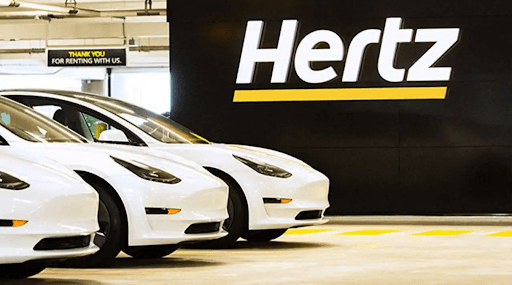
Credit: Hertz
A lot of attention throughout the month of October was on Washington, where the (as-of-yet unpassed) reconciliation bill with major climate provisions was being negotiated, but there was a lot else going on as well. In particular, Hertz and Tesla announced a deal that should provide a great opportunity for consumers to try-before-you-buy EVs, Breakthrough Energy announced their first batch of their important Fellows program, news about a Evergreen Climate Innovations portfolio company being acquired, more activity in the EV battery material supply chain, learnings from corporate carbon offset investments, and more!
I’ll Wait For You, Climate Bill
There is an outline for the budget package which contains climate provisions, but it’s not quite a done deal yet. Robinson Meyer at The Atlantic has a good rundown of what is in there currently. Short answer? A heck of a lot of incentives to decrease emissions across the economy.
Hertz Goes Electric
Hertz announced they would purchase 100,000 new Tesla model 3s over the next couple of years. Although the business filed for bankruptcy last year amid the pandemic, it benefited from higher than expected used car prices when it sold off most of its fleet, and more recently has been a meme stock as well. In any case, it is turning over a new page with this announcement – 100,000 electric vehicles represents about 20% of Hertz’ total vehicle fleet. It’s also a different approach than rental car companies usually take, which is to buy base model vehicles at deep discounts. Hertz plans for half of these vehicles to be rented to Uber drivers who don’t own their own vehicles, which could be a good business marriage since the vehicles have lower operating costs than engine vehicles. Tesla’s connectivity features also make them easy to adopt relative to other EV models. More importantly, it’s also a great marriage for Tesla. This is a major order for them – about 10% of their production capacity; it will also amount to an enormous free advertising campaign for Tesla, which has famously declined to spend any money on direct ads. All in all, it should be a great way to introduce folks to EVs and provide new exposure. Today, the bulk of EVs sales are in California and clustered around prosperous cities – but most Americans haven’t had much interaction with an EV yet. Renting a car is an extremely low-commitment way to test out an electric vehicle. I think this will actually turn out to be a very tangible step towards mainstreaming EVs in the U.S.

Source: Nature
Lessons from Corporate Carbon Removal Purchases
An article in Nature distilled some useful lessons from analyzing the corporate carbon removal purchase investments Microsoft and Stripe have made (covered previously in the Roundup). The key takeaways:
- The supply of carbon removal solutions is tiny compared to what will be needed to achieve net-zero emissions by 2050.
- Many proposals did not meet the companies’ standards – in general, there is a lack of clear definitions and accepted standards in the space.
- Systems don’t currently distinguish between short-term CO2 storage (in a tree or farmland, for example) versus long-term storage (pumping CO2 into the ground and turning it into minerals, for example).
To better develop markets for carbon, the authors recommend “consistent standards for measuring, verifying and accounting for carbon removal that internalize differences in the quality and durability of carbon stored in the biosphere and the geosphere.” Getting the markets and standards right in this space is really critical. Done poorly, it could result in the worst possible combination: companies end up primarily buying the cheapest and least rigorous offsets, which could actually make getting to net-zero harder because it could lead to the market being flooded by low quality offsets, undercutting the more rigorous (but more expensive) solutions that effectively sequester CO2 for longer periods. On a related note, data from the Voluntary Registry Offsets Database, developed by the Berkeley Carbon Trading Project at the University of Berkeley, California‘s Goldman School of Public Policy, indicates that carbon credits are dominated by forestry and land use today, with carbon capture and storage accounting for less than 2%.
Breakthrough Energy Fellows: The Right Model for Clean Energy Innovation?
Breakthrough Energy recently announced the first cohort of Breakthrough Energy Fellows. This program is a huge deal for deeptech climate innovation. The initiative is providing substantial early funding for scientists developing promising technology solutions in difficult to decarbonize areas, like industrial emissions, cement, steel, and fertilizer. When solutions are still at an early stage, it is really, really hard to scrape together sufficient funding to develop these technology businesses. Evergreen Climate Innovations works to address this gap, but it’s too large a gap for any one entity to completely fill. When, in 2030, we look back to identify what made a difference in addressing climate innovation challenges, I fully expect this Fellows program to be high on this list. This program is being spearheaded by my friend and former colleague Ben Gaddy, so I’m biased, but I would be excited regardless! Ben is particularly well suited to shape this effort. His research, captured in the widely cited paper, Venture capital and cleantech: The wrong model for clean energy innovation, highlighted many of the challenges inherent in funding the commercialization of climate solutions. Importantly, it’s not that venture capital will never make sense for these climate solutions companies – just that many of them are too early for the venture investment to be profitable in the short time frame that is standard for venture capital, given the complexity of scaling up these solutions. However, with sufficient early support, companies can reach a more mature stage while delaying “starting the clock” on venture funding. Ben and his co-authors make this point in the conclusion of the paper:
“Indeed, if cleantech entrepreneurs can use shared resources from federally funded research centers, university labs, private research institutes, or incubators, they can avoid the VC countdown clock to exit. And the rise and fall of hundreds of start-ups might have an upside if a new generation of public and private support avoids the missteps of the cleantech VC boom and bust.
I was also happy to see one of the first fellows was Gary Ong, the CEO of Celadyne Technologies, who received the Nicor Gas Multicultural Innovator Award from Evergreen Climate Innovations earlier this year. Congrats Ben, Ashley, Gary, and everyone else affiliated with the initiative!
More North American Battery Materials Supply Chain News
As we discussed last month, there has been a surge in activity lately in the North American battery materials supply chain.
“As Americans buy more EVs, companies are also looking to source more supply domestically. As the industry scales and matures, it is in a position to make forward-looking new investments — if you are going to spend a bunch of money on a new thing, you’d like that new thing to be compatible with the future, and one aspect of that is more robust and sustainable supply chains.”
Of note in October, GM and GE are collaborating to develop a rare earth materials supply chain for electric vehicles and renewable energy input materials, with a focus on setting up supply chains in North America and Europe (and, specifically, not in China, which dominates them today).
“They initially plan to concentrate on making a North America- and Europe-based supply chain of magnet manufacturing, as metal alloys and finished magnets made from rare earth materials are critical components used in creating electric motors for automotive and renewable power generation.”
Bloomberg Hyperdrive’s James Frith also shared this great chart and stat on North America’s growing battery industry:
“Combined with announcements south of the border, North America has plans for over 400GWh of capacity to be built this decade (compared to just over 50GWh today). This is still short of the 508GWh annual demand the region will have by 2030, so expect more announcements to come.”

Credit: Bloomberg Hyperdrive
Other News
Evergreen Climate Innovations portfolio company Agentis was recently acquired by Uplight. Congrats to Tim, John, Paul, and the whole team there! Link

Illinois recently passed the Reimagining Electric Vehicles (REV) Act, which will provide tax credits to manufacturers of electric vehicles and their supply chain partners. Link Bloomberg’s Hyperdrive newsletter recently highlighted how lithium ion has come to dominate the stationary storage sector. I’ll be interested to see if other solutions, like zinc, make some inroads in the coming years as the supply chains for lithium ion batteries are stressed by the ramp up in electric vehicle production, although lithium ion is clearly the market standard today.

Evergreen Climate Innovations portfolio company NuMat Technologies was recently awarded $3.5 million by the state of Illinois to help build out its wet lab space. Link

Interesting new models for journalism have emerged over the last several years that point to effective approaches for high quality journalism. For example, I get my local news from a non-profit news organization, Block Club Chicago, which maintains a hyper-local focus. Several months back, after Greentech Media’s owner (Wood MacKenzie) decided to shut down the media platform, it evolved into Canary Media with the support of non-profit RMI. And more recently, Breakthrough Energy launched Cipher, with a mission to “help accelerate the technological transformations required to get to net-zero greenhouse gas emissions by 2050 through trustworthy and objective journalism.” In the case of Block Club, its status as a non-profit means it is under less economic pressure; in the case of Canary Media and Cipher, their work is supported by the non-profits whose missions are aligned with their focus areas.

Norway is on track to hit 100% of electric and hybrid vehicles (i.e. no cars with only internal combustion engines) sold in the country next year, 3 years ahead of the country’s target. h/t Trucks Fot Link
Research suggests using recycled battery cathodes can actually make better batteries – the recycled cathode powder was more porous and less brittle (both good things in this case). h/t Trucks FoT Link
Electric Last Mile Solutions and Ample are partnering to offer EV delivery fleets with swappable battery technology. Link
A pilot with National Grid, Proterra, and Highland Electric Fleets showed the potential to leverage electric school buses to support the electric grid leveraging vehicle-to-grid technology. School buses could be great candidates for grid assets, since there are significant chunks of the year (holidays, summers, etc…) where they are sitting unused. Link
Detroit-based EV battery technology company Our Next Energy raised a $25 million Series A from Breakthrough Energy Ventures, BMW, and Volta Energy Technologies. Link